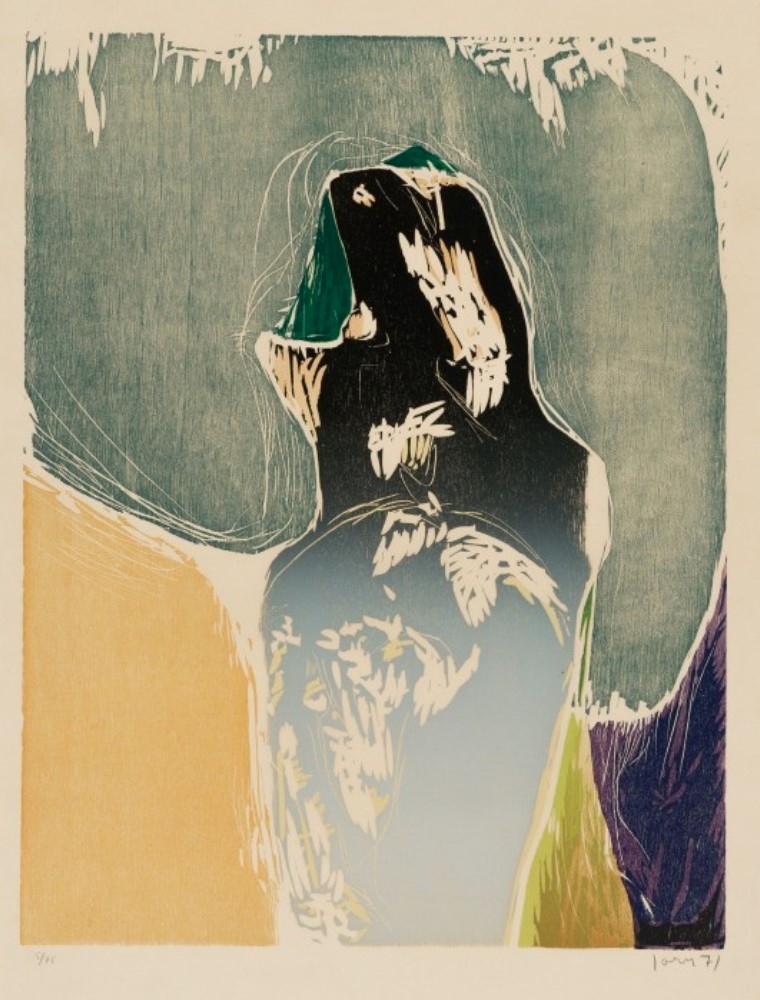Woodcut in color on paper by Asger Jorn – Titled: The future of the past, 1971
Original limited edition fine art print by Asger Jorn – Titled: De toekomst van het verleden, 1971 (The future of the past)
Wood cut in color signed and dated in pencil on lower right by the artist and also numbered in pencil on lower left. One of an edition of 75 signed, dated and numbered woodcuts.
Not framed.
Dimension: 66.5 x 50 cm – 25.4 x 19.7 in.
Publisher: Atelier Clot
Printer: Clot Bramsen & Georges, Paris
Reference: “Asger Jorn – Werkverzeichnis Druckgrafik” Gallery van de Loo, Munich 1976, cf. no. 402 ill.
Artwork is not available anymore! Sold – Thank you.
For more information on artist or other contact gallery.
Clic here to see more fine art prints>>
Clic here to see more relief fine art prints >>
Asger JORN (1914 – 1973)
Asger Oluf Jorn aka Asger Jorn was born on March, 3; 1914 and died on the 1 of May 1973. He was a Danish painter, sculptor, ceramic artist, and author. He was a founding member of the avant-garde movement CoBrA and the Situationist International. He was born in Vejrum, in the northwest corner of Jutland, Denmark, and baptized Asger Oluf Jørgensen.
From 1937 to 1942, he studied at the Royal Danish Academy of Fine Arts in Copenhagen.
The occupation of Denmark by Nazi Germany was a time of deep crisis for Jorn, who had been deeply inculcated with pacifism. The occupation initially sank him into deep depression, but he subsequently became active in the communist resistance movement.
After the war, he complained that opportunities for critical thinking within the context of the communist arena had been curtailed by what he characterised as a centralised bourgeois political control. Finding this unacceptable, he broke with the Communist Party of Denmark.
He traveled again to France where in the autumn of 1948 he, together with Christian Dotremont, Constant and others, founded the CoBrA, a European avant-garde art movement and edited monographs of the Bibliothèque Cobra. However by 1949 Jorn had started a relationship with Matie van Domselaer, the daughter of the composer Jakob van Domselaer. This caused tension in the CoBrA group with the Dutch artists boycotting a conference held at Bregnerød later that year. Matie and Jorn were married in 1950 and they had a son Ole and daughter Bodil. The CoBrA group dissolved in 1951.
In 1954 he met Guy Debord, who was to become a close friend. The two men collaborated on two artist’s books.
He participated in the conference that led to the merger of the International Movement for an Imaginist Bauhaus, the Lettriste Internationale, and London Psychogeographical Association to form the Situationist International in 1957.
In 1961 he amicably quit his activity in the SI, still fully supporting its contents and goals, and continuing to support it financially, but believing that the new strategy of the SI was ineffective.
His first American solo exhibition was at the Lefebre Gallery in 1962. After 1966, Jorn continued to produce oil paintings while traveling throughout Europe collecting images with photographer Gerard Franceschi for his vast archive of “10,000 Years of Nordic Folk Art”. He traveled extensively, to Cuba, England, and the Far East. Jorn traveled to the United States for the only time in 1970, for a gallery opening at Lefebre Gallery. He had earlier asserted that he refused to travel to a country that made visitors sign a statement maintaining that they were not communists.
In 1964, he was awarded a Guggenheim Award including a generous cash prize, by an international jury assembled by Lawrence Alloway. The following day Jorn sent this telegram to the president of the Guggenheim, Harry F. Guggenheim.
He died in Aarhus, Denmark on 1 May 1973. He is buried in the cemetery at Grötlingbo Church, on the island of Gotland in Sweden.
Asger Jorn willed his property and the works of art located inside to the Municipality of Albissola Marina, Savona, so the Italian museum called “Casa Museo Jorn” was created for displaying his works.
#Biography
Date:
December 17, 2021
